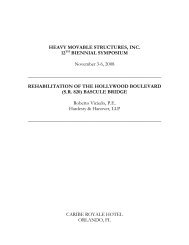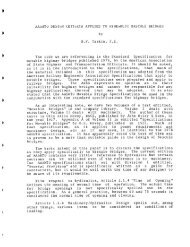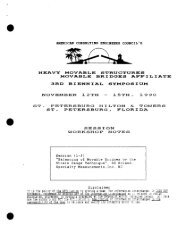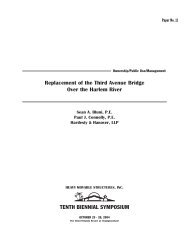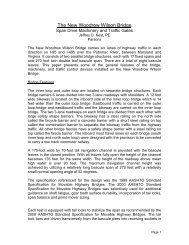Route 33 Over Pamunkey River, West Point, VA - Heavy Movable ...
Route 33 Over Pamunkey River, West Point, VA - Heavy Movable ...
Route 33 Over Pamunkey River, West Point, VA - Heavy Movable ...
- No tags were found...
You also want an ePaper? Increase the reach of your titles
YUMPU automatically turns print PDFs into web optimized ePapers that Google loves.
Paper No. 37Machinery/MechanicsDesign of Machinery for <strong>Pamunkey</strong> Bridge(<strong>Route</strong> <strong>33</strong> over <strong>Pamunkey</strong> <strong>River</strong>, <strong>West</strong> <strong>Point</strong>, <strong>VA</strong>)Scott SnellingParsons Brinckerhoff Quade & Douglas, Inc.HEAVY MO<strong>VA</strong>BLE STRUCTURES, INC.TENTH BIENNIAL SYMPOSIUMOCTOBER 25 - 28, 2004The Omni Orlando Resort at ChampionsGate
Design of the Machinery for <strong>Pamunkey</strong> BridgeABSTRACTRedundancy and reliability were VDOT’s primary concerns for the design of the machinery for this 173-foot-long double-leaf trunnion bascule. The bridge is not currently expected to see any openings formarine traffic. Bi-weekly maintenance openings are scheduled; however the owner acknowledges thatactual maintenance openings could occur much less frequently.These considerations led each leaf to be designed with two independent and fully redundant operatingsystems. Other reliability related features of the operating system include reducers with gears fullyimmersed in oil and an automatic lubrication system for all mechanical components. In addition, thecenter locks were designed to allow emergency operation via a chainfall, in the event of actuator and handwheel failure.Additional information relevant to the design of bascule bridges is included in the Appendix. AppendixA compares the horsepower requirements for prime movers, calculated using four differentmethodologies. Appendix B presents the equations used to determine the force in the cylinder of ahydraulically operated bascule span, as a function of span angle.l. BACKGOUNDThe existing bridge that this project will replace is a swing span. Also included in this project is the replacement of the nearby <strong>Route</strong> <strong>33</strong> over Mattaponi <strong>River</strong> fixed bridge.The following is excerpted from the Executive Summary of the “<strong>Route</strong> <strong>33</strong> over <strong>Pamunkey</strong> <strong>River</strong> <strong>Movable</strong>Bridge Alternatives Study”, February 7, 2003:“Three types of movable bridges have been investigated as a replacement for the existing bridge carrying<strong>Route</strong> <strong>33</strong> over the <strong>Pamunkey</strong> <strong>River</strong> in <strong>West</strong> <strong>Point</strong>, Virginia” The three types are a double-leaf Scherzer(rolling) bascule; a double-leaf trunnion bascule; and a swing span. Each alternative provides a 100-footwidehorizontal navigation channel and a 55-foot-high channel above Mean High Water in the closedposition, with unlimited clearance in the open position. The vertical clearance in the closed position isadequate for the existing barge traffic on the river without opening the bridge. An opening would only berequired for ocean-going vessels. Ocean-going vessels have used the channel in the past, but do not do so atthis time, consequently it is not anticipated that the bridge will open on a regular basis.A Scherzer-type bascule bridge with a conventional mechanical system and SCR control system isrecommended for the new <strong>Pamunkey</strong> Bridge. The Scherzer-type bascule, not including approaches, isestimated to cost $14 million or about $0.5 million less than the trunnion-type bascule and $3 million lessthan the swing span alternative.”2. DESIGN MANDATEVDOT selected a double-leaf trunnion bascule despite indication that it would have a marginally higherinitial cost, when compared to a Scherzer rolling-lift bascule. VDOT felt that the trunnion type would beeasier and cheaper to maintain and would be more compatible with their existing movable bridgeinventory.
A design meeting was held and VDOT gave PB the following direction (excerpted from the meetingminutes 03.18.2003).• VDOT wants machinery that is simple and easy to maintain. The low duty cycle of the bridge,as well as uncertainty of the future exercise schedule requires that the machinery and controlsystem be designed with this in mind.• The Department would prefer two independent drives rather than a common primary reducer.PB will submit concept sketches to resolve issue prior to preliminary design.• The enclosed gear reducers should be oversized to allow all moving parts to be submerged in oilat all times. This will reduce corrosion on the gears/shafts/bearings. An internal circulatingpump was discussed but discarded in favor of larger cases.• All machinery spaces are to be sized to allow easy maintenance and cleaning access around theequipment.3. DESIGN DEVELOPMENTA narrative of the design decisions made for each system of Bridge Machinery follows. The BridgeMachinery encompasses the Operating Machinery, Buffers, Trunnions, Locks, and the LubricationSystem.Operating MachineryA traditional machinery layout, see Figure 1, is not redundant. In the event of failure of the primaryreducer, the span will be inoperable. In order to accommodate VDOT’s desire for independent drives,two concepts were proposed, each involving two totally independent operating systems per leaf. Onlyone operating system would drive the bridge during any given opening.• Concept 1: A conventional rack is mounted to each trunnion girder. However, the span wouldbe operated by only one rack/pinion at a time. In order to transfer the operating torque from thedriven bascule girder to the opposite, non-driven bascule girder, a torque tube was proposed.See Figure 2.• Concept 2: Two racks are mounted to the pier on either side of the centerline of the roadway.The pinions and reducers are mounted on the counterweight. The motors and brakes aremounted on the pier, outboard of each trunnion. A drive shaft runs through the center of eachtrunnion to connect the motor with the reducers. See Figure 3. A similar, but non-redundant,version of this scheme was used by PB in 1977 on the 3 rd St. Bridge in Deleware. See Figure 4.VDOT preferred Concept 1, based on this PB developed multiple schemes for the machinery layout.Since the redundant concept involves the power from one motor going to only one pinion, it would bepreferable to provide a single, horizontally mounted, reducer for each operating system. However, thiswould result in a very long reducer. In fact, this reducer would be longer than the space allotted for themachinery room. Next, we investigated using horizontally mounted primary and secondary reducers.This scheme was also too large for the machinery room.A redundant operating system not only requires more reducers than a traditional system, each reducermust also have twice the capacity. Therefore, the configuration of the reducers became a criticalcomponent of not only the mechanical, but also the structural design.
In a further attempt to fit the reducers into the allocated space of the machinery room, two schemesutilizing vertically mounted reducers were developed.• Scheme A: A single stage secondary reducer is mounted vertically. A triple stage primaryreducer is horizontally mounted. See Figure 5.• Scheme C: A single quadruple stage reducer is vertically mounted. See Figure 6.It was felt that the single vertical reducer of Scheme C would be too massive and awkward. Therefore,we decided to develop Scheme A.It was shortly discovered that, while Scheme A fit the machinery room when viewed in plan(horizontally), when viewed in elevation it was apparent that the vertical primary reducer was too tall. Itwould interfere with the counterweight when the span was opened. The span length and counterweightlength would need to be increased to facilitate the redundant operating system.At this point PB prepared a Mechanical Construction Cost Estimate for both the traditional and redundantoperating systems. The traditional system was estimated to be $2M or 50% less than the redundantsystem. It was noted that this estimate did not include the added cost to both the movable spansuperstructure and foundations. PB recommended the traditional system.VDOT reaffirmed its commitment to the redundant concept and PB proceeded with its development. Thesize of the machinery room was increased by lengthening the span ~5 feet and altering the counterweight.Enough space was gained to allow the use of two horizontally mounted reducers per operating system.The final machinery layout is shown in Figure 7.The prime mover is a 75hp at 900 rpm wound rotor motor. The primary reducer has a ration of 200:1.The secondary reducer has a ration of 6.0:1. The 19 tooth pinion has a pitch diameter of 50 inches andmates with a 14 foot radius rack.PB recommended that the AGMA requirements for surface durability, specified by AASHTO 1988M2.6.12, only be applied to the enclosed reducers, not the open gearing. This allowed softer, moretraditional, grades of steel to be used for the rack and pinion. ASTM A148 grade 90-60 Cast Steel(BHN=180) was used for the rack and AASHTO M102 class D (BHN=149) was used for the pinion. Inorder to meet the AGMA surface durability requirements, materials in the range of 300-350BHN arecommonly used. The softer grades of steel have proven durability through years of use. The primaryadvantage being that they can overcome imperfect alignment by “wearing in.”The pinion shafts are supported by bronze bushed pillow block bearings. Bronze bushings were chosenover rolling-element bearings because of their simplicity, ease of maintenance, replaceability, anddurability.Concrete machinery supports were preferred, due to their lower cost when compared with steelweldments. In order to facilitate shop alignment, a steel primary support weldment is provided.
The brakes for each operating system are sized for the entire span. In order to prevent all the brakes fromactivating in the event of a power loss, the brakes for one operating system per span have a longer delaysetting. It should be noted that even if the brakes from both operating systems on a leaf were activatedsimultaneously (unintentionally), neither operating system would experience greater than design loads,however the span would decelerate at twice the design rate.Buffers and Electrical SystemThe relay based contactor/resistor control system was requested by VDOT for its ease of maintenance andrepair. This style of control system is more primitive than the SCR drives that have been commonly usedsince the 1970’s. The contactor/resistor control system does not provide a fine degree of control,therefore it was necessary to provide buffers.Hydraulic buffers, as opposed to pneumatic buffers, were selected for their durability and lack ofmaintenance requirements. The specified force to displacement curve for the buffers is shown in Figure8. This curve was designed to smoothly slow the span from full-speed to a complete stop over the 16”stroke of the buffer. However, since the control system is designed to automatically switch the bridge to10% creep speed degrees before it closes, the buffers should never experience this worst case scenario.Therefore, it is equally important that the buffers be easily compressed when the bridge is moving atcreep speed.TrunnionsA traditional, single shear design was selected for the trunnions, see Figure 9. The primary advantage ofthis design is that it allows a greater span opening angle and a shorter, deeper counterweight whencompared to a double shear trunnion design. This is because a double shear trunnion does not require abearing and pedestal to be mounted inboard of the trunnion girders.The connection between the trunnion collar and bascule girder was designed for bearing. Duringerection, trunnion alignment is adjusted with wedges that fit between the trunnion and trunnion girder.Some consideration was given to the use of spherical plain trunnion bearings. This type of bearing wouldsimplify the alignment of the trunnion bearing to the trunnion. The trunnion is aligned such that bothends are at the same elevation. However, under full dead load the trunnion sags and takes the shape of abananna, see Figure 10. In order to achieve full bearing between the trunnion and a traditional bronzebearing the bearing must be mounted at an angle, when viewed in elevation. This may require multipleiterations of jacking the span and shimming before full bearing is achieved.The use of spherical plain bearings would do away with the iterative bearing alignment process, since aspherical bearing can accommodate a few degrees of misalignment while still providing full bearing.Sperical plain bearings have been successfully used on the Erasmus Bridge in Rotterdam, completed in1996. Spherical plain bearings appear to be a suitable and labor saving solution. See Figure 11.However, we found that it would take up to a month to get a cost estimate on an appropriate bearing.Given the lack of time and uncertainty in pricing, it was determined that a traditional bronze trunnionbearing design was the prudent choice. This type of bearing also has the advantage of many potentialfabricators, as compared with the few companies in the world that would fabricate a suitable sphericalplain bearing.
Center LocksMaintenance was of primary concern while designing the center locks. The locks are located outboard ofthe girders, such that they are accessible from a ladder at center span. The motive force comes from alinear actuator. The linear actuator may be disconnected from the lockbar and rotated out of the wayallowing the locks to be engaged and disengaged with a chainfall, see Figure 12. Replaceable wear platesare used on both the forged steel lockbar and the cast bronze guides and receivers. Tail locks were notprovided on this bridge.Lubrication SystemAn automatic lubrication system (single line parallel type) was specified. The system supplies grease tothe pinion pillow block bearings, the trunnion bearings, the buffer pivot pin, and the span lock guides andreceivers. The system will be activated by a push button mounted on the bridge control desk. In general,the preferred grease for automatic lubrication systems is EP1. However, more viscous EP2 grease, in 120lb drums, was selected since EP2 grease is more typical in movable bridge applications. This will preventVDOT from being required to stock and supply different grease for this one bridge.4. CONCLUSIONAt the time of this writing, the <strong>Route</strong> <strong>33</strong> over <strong>Pamunkey</strong> <strong>River</strong> bridge project is out to bid. Bids are dueon Sept 22, 2004.5. AKNOWLEDGEMENTSMilton Pritchett, VDOT, Project Manager; Bob Jacobus, VDOT, Mechanical; Fred Parkinson, PB,Project Manager and Structural; Mike Abrahams and Bill Kam, PB, Mechanical; Mark VanDeRee,Rick Newcomb, Akbar Siddiqui, and James Chin, PB, Electrical;I would also like to thank the industry representatives that provided invaluable technical and costinformation: James Alison, Steward Machine; Craig Winters, Taylor Devices; Rich Thomas, RACOInternational; Bobby Harris, Lincoln Industrial, Gill Detweiler, SKF6. APPENDIXThe information presented in the Appendices does not directly relate to the <strong>Pamunkey</strong> Bridge, howeverthe topics are relevant to the design of bascule bridges. Appendix A compares the horsepowerrequirements for the prime movers, calculated using four different methodologies. Appendix B presentsthe equations used to determine the force in the cylinder of a hydraulically operated bascule span, as afunction of span angle.
Appendix A - Motor Sizing ComparisonA comparison of results from four different methodologies used to calculate the minimum power requiredfor the prime movers of bascule leaves are presented in Tables A.1 and A.2 below. The fourmethodologies are as follows:1. 2000 AASHTO: The prime movers, for a mechanical drive system, are sized in accordancewith section 5.4 of AASHTO LRFD <strong>Movable</strong> Highway Bridge Design Specifications, FirstEdition 2000.2. 1988 AASHTO Same Times: The prime movers, for a mechanical drive system, are sized inaccordance with section 2.5.3 of Standard Specifications for <strong>Movable</strong> Highway Bridges, 1988.Load Conditions A, B, and C are all applied assuming the normal opening time.3. 1988 AASHTO Different Times: The prime movers, for a mechanical drive system, are sizedin accordance with section 2.5.3 of Standard Specifications for <strong>Movable</strong> Highway Bridges,1988. Load Condition A is applied assuming a normal opening time. Load Conditions B & Care applied assuming 1.5 and 2 times the normal opening time, respectively.4. Hydraulic Operating Machinery: The prime movers, for a hydraulic cylinder drive system, aresized in accordance with section 2.5.3 of Standard Specifications for <strong>Movable</strong> HighwayBridges, 1988. Load Conditions A, B, and C are all applied assuming the normal opening time.For mechanical drive systems one motor operates the leaf at a time. For the hydraulic cylinder drivesystems two motor/pump groups operate the leaf at a time. The differences between the power requiredfor <strong>Pamunkey</strong> Bridge’s redundant vs. traditional layouts, when using the 1988 AASHTO specs, is due tothe different motor overload factors specified in section 2.10.14 for one vs. two motor installations of 1.25vs. 1.5, respectively. The generic bridges identified as Highway and Railroad are calculated assuminganti-friction trunnion bearings, while <strong>Pamunkey</strong> has bronze plain bearings.There are some differences of opinion with regards to whether, when designing in accordance toAASTHO 1988 specs, it is appropriate to use different opening times when applying Load Conditions A,B, and C. The specifications allow for the use of different times for different loads, however mechanicaldrive systems (with Wound Rotor Motors and SCR drives) cannot physically operate at different timesunless a gearbox that can shift to different gear ratios is provided.
Appendix B - Equations of Motion for Hydraulic Cylinder Bascule BridgeGoal: Relate thrust (F) in cylinder to angle of span (Ф). See Figure 12 for an example sketch of ahydraulic cylinder operated bascule. See Figure 13 for a sketch defining the terms below.
6. FiguresFigure 1– Traditional Machinery LayoutFigure 2– Elevation Sketch of Redundant Concept 1
Figure 3– Plan Sketch of Redundant Concept 2Figure 4 – Machinery Plan and Elevation for 3 rd St. Bridge
Figure 5 – Scheme A Sketches
Figure 6 – Scheme C Sketches
Figure 7 – Final Machinery Plan & Elevation for <strong>Pamunkey</strong> BridgeFigure 8 – Buffer Output Curve at Full Speed of 0.211 ft/s
Figure 9 – Elevation of Trunnion for <strong>Pamunkey</strong> BridgeFigure 10 – Trunnion Deflection Sketch. “Gap” calculated to be 0.036”. Since this isgreater than the RC6 Fit Tolerance, Bearing must be shimmed at a slight angle.
Figure 11 – Drawing of Spherical Plain Bearing used on Erasmus BridgeFigure 12 – Elevation of Span Lock
Figure 13 – Elevation Sketch Showing Hydraulic Cylinder Operated Trunnion BasculeFigure 14 – Elevation Sketch Defining Terms for Appendix B





